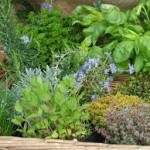Planting your own collection of herbs, you can save money on buying them from the grocery store while having the added benefit of freshness.
Most people think of herb propagation they automatically think of cooking, but herbs are also grown for their pleasant aroma and their beauty.
One of the most common herbs gown is basil (Ocimum basilicum).’Dark Opal’ and regular green basil are beautiful additions to any garden and often used as decoration. Dark Opal has light pink flowers and dark red leaves. Basil isn’t just used for its looks; it is used for extra flavor in tomato juices and pastes.
Chives (Allium schoenoprasum) are very petite looking and resemble a blade of grass. They grow well in dry season. Their toughness and sturdiness makes chives a perfect plant and hassle free for herbs propagators. Chives have insect repelling properties that can be used in gardens to control pests. The chive is a bulb-forming herbaceous perennial plant. In culinary use, the scapes are diced and used as an ingredient for fish, potatoes, soups, and other dishes.
Mint (Mentha spicata), is easy to grow and is good to use in mint jelly, mint juleps, lemonade, and any other kind of fruity drink. Mint is also good in herb gardening for its unique minty smell.
Two herbs that appear in nearly everyone’s herb garden are thyme (Thymus vulgaris) and sage (Saivia officinalis) . Both of these herb gardening favorites are used for flavoring soups, chicken, turkey, pork, and other sausages. Sage is also grown sometimes for its beautiful blue spiked flowers.
Lavender (Lavandula) is probably the best smelling herb in all of herb gardening and is often used in candles, as a perfume scent, and to improve the smell in linen chests. The light purple flowers smell absolutely lovely.Lavender flowers are occasionally blended with black, green, or herbal tea, adding a fresh, relaxing scent and flavor. They are sometimes used as cake decorations and flavor baked goods and desserts, it pairs especially well with chocolate.
Other types of herbs often grown in herb propagation include borage (Borago officinalis) usually used in salads. Vegetable use of borage is common in Germany, in the Spanish regions. Borage as companion plant, is said to protect or nurse legumes, spinach, brassicas, and even strawberries. In Italy, borage is commonly used as filling of the traditional pasta ravioli and pansoti. In Iran, people sometimes put it in their tea.
Chervil (Anthriscus cerefolium) is used to season poultry, seafood, and young vegetables. It is particularly popular in France, where it is added to omelettes, salads, and soups and it has a faint taste of liquorice or aniseed.
Sweet marjoram (Majorana hortensis) flavors lamb, fish, salad, and soup. It is cultivated for its aromatic leaves, either green or dry, for culinary purposes. It is indigenous to the Mediterranean area.
Sesame (Sesamum indicum) flavors crackers, cookies, and bread. Sesame is very drought tolerant plant, and is considered to be the oldest oilseed crop known to man. The rich nutty flavor, it is a common ingredient in cuisines across the world.
Dill (Anethum graveolens) flavors meats and used in pickles. Fresh and dried dill leaves are used as herbs, mainly in Finland, Sweden, the Baltic, in Russia, and in central Asia. Dill is the herb most often added to fish when consumed as food.
Herb gardening allows gardeners to use herbs from their own garden for cooking, looks, and smell.
Herb propagation will produce much fresher herbs with more flavor than store bought herbs, and are a lot cheaper.
